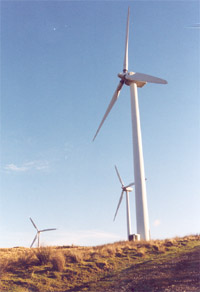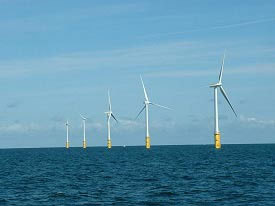 |
 |
 |
 |
 |
 |
 |
 |
 |
 |
 |
Important issues
Infrastructure within the energy sector comprises of supply facilities such as power stations and wind turbines, the network of pipes and cables distributing the supply and the operational facilities and users including building services such as heating systems and technologies. Good design and management can significantly reduce the amount of energy that is used at all levels of infrastructure. This management should take place at all levels from national government through to all members of the public within the households.
A series of important issues have been raised throughout the duration of the PETUS project through the case studies and stakeholders.
i) The visual impact of energy supply systems
The EU target is to derive 12% of the EUs total energy consumption and
22% of electricity from renewable sources by 2010 (EEA, 2003). In order to achieve
these targets new sources of renewable energy are required. There is a lack
of acceptance of visual impact of renewable energy supply systems due to the
demand for preservation of natural landscapes.
PETUS case studies investigations have primarily identified onshore and offshore wind farm developments as renewable energy sources. Wind farm developments present the problem of visibility and aesthetics with regard to their effect on the surrounding landscape.

These concerns have led to discussions within member countries at the national
and neighbourhood level. The issue of siting new wind farms often results in
strong emotions, to reach the renewable energy targets these projects need support.
For more information: The visual impact of energy supply systems(.pdf)
ii) Security of energy supply
"The European Unions own energy supply barely covers half of its
needs. If nothing is done by 2030, the share of fossil fuels is going to increase"
(2001c). Due to the EUs dependence on imported oil and gas, currently
50%, with a projected rise to 70% by 2030 if energy sources remains the same,
energy supply is not secure, but vulnerable to price cut or increases which
can have severe impacts on the economy.
In addition to investigating alternative energy sources, the opportunity to reduce energy requirements in the EU is significant. A1% increase in energy efficiency in private households, appliances, buildings and the transport sector, per two-thirds of the available savings potential by 2010, could according to projections from the EU Commission, result in avoiding carbon dioxide emissions of almost 200Mt/year or around 40% of the EUs Kyoto commitment (CAN 2005).
By increasing the amount of energy produced in the EU from renewables and improving energy efficiency, dependence on other nations and the environmental, social and economic risks associated with it will be reduced.
For more information:Security of energy supply(.pdf)
iii) Ownership of renewable energy sources to gain public support.
By incorporating issues and methods of encouraging public ownership of schemes,
the opposition to the development of renewable energy schemes could be reversed
when benefits can be clearly seen.
Denmark has a long history of public involvement and shared ownership of renewable energy schemes. This approach has often resulted in public support for potential renewable energy schemes where benefits are clearly illustrated, and as a result Denmark now gets 18% of its electricity from wind power alone, and has created an industry that has more jobs than the electricity sector itself (European Renewable Energy Council, 2005).

Therefore since there is a need to encourage the take up of renewable energy
sources, for which public support is needed, developers need to be aware that
community ownership, consultation and support is extremely important if renewable
energy sources are to be successfully developed. An example of this approach
can be seen in the PETUS case study North Hoyle Offshore wind farm where a comprehensive
public consultation and participation process ensured that information on the
decision making process was disseminated on a regular basis. Consultation involved
taking on board the views of policy makers, partners, agencies, businesses (including
those in the tourism sector) and other wind farm operators through face to face
and semi-structured telephone based discussion. Public perception studies were
undertaken supported by the use of photo montages of the development, to assist
people in visualising the proposed development. In addition funds from the energy
produced by the Offshore wind farm are provided to the community by the developer
for local community schemes.
The Awel Aman Tawe Community Energy case study conducted a 10 month long public participation process for a community owned wind farm in a South Wales Valley.
For further information: The ownership of renewable energy sources to gain public support (.pdf)